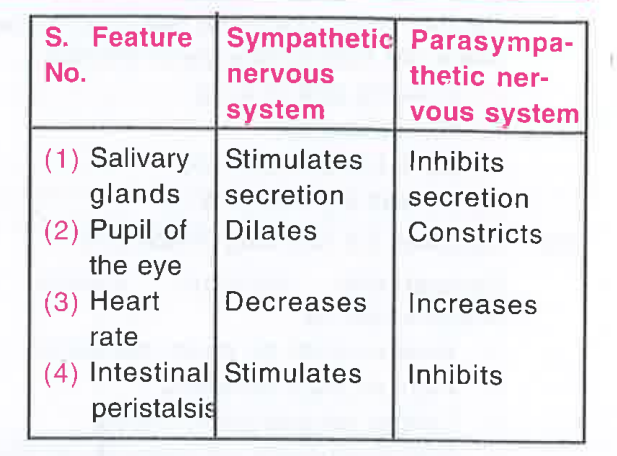Parasympathetic and Sympathetic system
Step-by-Step Text Solution
1. Definition of Autonomic Nervous System (ANS):
- The Autonomic Nervous System (ANS) is a part of the peripheral nervous system that controls involuntary bodily functions. It is divided into two main branches: the sympathetic nervous system and the parasympathetic nervous system.
2. Function of the Parasympathetic Nervous System:
- The parasympathetic nervous system is primarily responsible for the "rest and digest" response. This means it helps the body to conserve energy and promotes maintenance activities when the body is at rest.
3. Function of the Sympathetic Nervous System:
- In contrast, the sympathetic nervous system is involved in the "fight or flight" response. It prepares the body to respond to perceived threats or emergencies by increasing alertness and metabolic activity.
4. State of the Body:
- The parasympathetic system aims to bring the body to a state of calm and relaxation. It promotes functions that occur when the body is at rest.
- The sympathetic system prepares the body for potential danger, increasing heart rate and blood flow to muscles.
5. Neuronal Structure:
- The sympathetic nervous system has shorter pre-ganglionic neurons, which allows for a faster response time.
- The parasympathetic nervous system has longer pre-ganglionic neurons, resulting in a slower response time.
6. Effects on the Body:
- The parasympathetic nervous system causes the pupils to constrict and stimulates the production of saliva.
- The sympathetic nervous system causes the pupils to dilate and inhibits saliva production.
7. Heart Rate Regulation:
- The parasympathetic nervous system slows the heartbeat, promoting a state of rest.
- The sympathetic nervous system increases the heartbeat, preparing the body for action.
Summary of Differences:
- Parasympathetic: Rest and digest, calm state, longer neurons, constricts pupils, stimulates saliva, slows heartbeat.
- Sympathetic: Fight or flight, prepares for danger, shorter neurons, dilates pupils, inhibits saliva, increases heartbeat.
---
- The Autonomic Nervous System (ANS) is a part of the peripheral nervous system that controls involuntary bodily functions. It is divided into two main branches: the sympathetic nervous system and the parasympathetic nervous system.
- The parasympathetic nervous system is primarily responsible for the "rest and digest" response. This means it helps the body to conserve energy and promotes maintenance activities when the body is at rest.
- In contrast, the sympathetic nervous system is involved in the "fight or flight" response. It prepares the body to respond to perceived threats or emergencies by increasing alertness and metabolic activity.
- The parasympathetic system aims to bring the body to a state of calm and relaxation. It promotes functions that occur when the body is at rest.
- The sympathetic system prepares the body for potential danger, increasing heart rate and blood flow to muscles.
- The sympathetic nervous system has shorter pre-ganglionic neurons, which allows for a faster response time.
- The parasympathetic nervous system has longer pre-ganglionic neurons, resulting in a slower response time.
- The parasympathetic nervous system causes the pupils to constrict and stimulates the production of saliva.
- The sympathetic nervous system causes the pupils to dilate and inhibits saliva production.
- The parasympathetic nervous system slows the heartbeat, promoting a state of rest.
- The sympathetic nervous system increases the heartbeat, preparing the body for action.
- Parasympathetic: Rest and digest, calm state, longer neurons, constricts pupils, stimulates saliva, slows heartbeat.
- Sympathetic: Fight or flight, prepares for danger, shorter neurons, dilates pupils, inhibits saliva, increases heartbeat.
Topper's Solved these Questions
- NEURAL CONTROL AND COORDINATIONBOOK - ICSECHAPTER - NEURAL CONTROL AND COORDINATIONEXERCISE - (Review question) Very short answer
56 Videos
- NEURAL CONTROL AND COORDINATIONBOOK - ICSECHAPTER - NEURAL CONTROL AND COORDINATIONEXERCISE - (Review question) short answer
26 Videos
- NEURAL CONTROL AND COORDINATIONBOOK - ICSECHAPTER - NEURAL CONTROL AND COORDINATIONEXERCISE - (Review question) Mark the odd one out
5 Videos
- NEURAL CONTROL AND CO-ORDINATION BOOK - ICSECHAPTER - NEURAL CONTROL AND CO-ORDINATION EXERCISE - NCERT EXERCISES WITH ANSWER (DIFFERENTIATE BETWEEN)
11 Videos
- PHOTOMORPHOGENESIS IN PLANTSBOOK - ICSECHAPTER - PHOTOMORPHOGENESIS IN PLANTSEXERCISE - REVIEW QUESTIONS (LONG ANSWER TYPE QUESTIONS)
6 Videos
Similar Questions
Knowledge Check
Parasympathetic and sympathetic nerves .........., to bring about minor adjustments in internal organ activity.
Aservice entirely different internal organsBwork antagonistically, most oftenCcome into play only during a fight-flight responseDnone of the aboveAll visceral effectors are innervated by both the parasympathetic and sympathetic divisions of the autonomic nervous system for coordinating various activities of the body. This concept is known as:
AA) sensory/motor regulationBB) dual innervationCC) autonomic summationDD) neurotransmitter trade-offWhich of the following options correctly idenifies the effect of sympathetic and parasympathetic neural system on given features or organs ?
AFeature/organSympathetic neural systemParasympathetic neural systemSalivary glandsStimulates secretionInhibits secretionBFeature/organSympathetic neural systemParasympathetic neural systemPupil of the eyeDilatesConstrictsCFeature/organSympathetic neural systemParasympathetic neural systemHeart rateDecreasesIncreasesDFeature/organSympathetic neural systemParasympathetic neural systemIntestinal peristalsisStimulates Inhibits
What are the effects of sympathetic and parasympthetic system on various activities ?
View SolutionAll of the following are under regulation of sympathetic and parasympathetic nervous systems except
View SolutionThe sympathetic and parasympathetic nervous systems are antagonistic in their actions. Give any two examples in support of this statement.
View SolutionWhich of the following is an incorrect match regarding effects of sympathetic and parasympathetic nervous systems on different organs?
View SolutionGiven below is a table comparing the effects of sympathetic and parasympathetic nervous system for four feature (1-4). Which one feature is correctly described ?

View Solution
